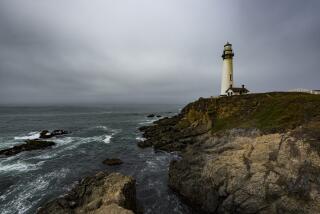Alaska Wilderness Is Bargain for Adventurous
KETCHIKAN, Alaska — Walt Panchyshyn dreamed often of traveling to Alaska, not only for its spectacular scenery, but to sample its world-class fishing. Particularly fishing for salmon.
“But (I) didn’t want to pay $4,000 a week for a lodge, or see anglers stand shoulder-to-shoulder, like they do on my hometown stream.”
With prompting from Marlis, his wife, and his sons Tony and Mike, Panchyshyn did some research and found a way to turn his dream into an affordable vacation reality. The Panchyshyns rented a wilderness cabin in one of Alaska’s national forests for $20 per day, and enjoyed some of the best silver salmon fishing of their lives, returning home to money in the bank. Panchyshyn says his memorable fishing excursion to Alaska cost less than $300 per person, excluding air fare.
Less adventurous anglers commonly pay thousands per week to receive such lodge amenities as five-course dinners, having their sheets turned back at night, being flown into wilderness areas each day to fish, and even having their fish unhooked by lodge staffers.
But, if you don’t mind catching and cleaning your own fish, cooking your own meals, and you enjoy hiking along miles of established trails in a wilderness environment away from the crowds, then you’re a prime candidate for a do-it-yourself Alaska salmon and trout adventure.
For the $20 per-day rate, outdoor enthusiasts can enjoy any of 197 cabins operated by the U.S. Forest Service and nestled in isolated salt water bays, or on remote streams filled with migrating salmon.
Some are in mountain passes in designated wilderness areas, where cutthroat and rainbow trout abound. Chances are you’ll have the stream or lake to yourself and the mountain goats, brown and black bears, deer and moose.
The cabins generally are modern and well-maintained, with furnishings that include an oil- or wood-burning stove, table and benches, but not beds. Many offer boats, oars, outhouse and firewood. Several cabins have ramps and boardwalks for the handicapped.
The greatest difficulty posed by the cabin system is choosing which one is right for your needs and desires. However, Fairbanks authors Chris and Adela Batin have helped solve that problem. For two years, they worked in cooperation with the U.S. Forest Service and produced a 356-page book that details the fishing opportunities at each cabin location as well as the best lures, flies and techniques used by the experts.
Also included is information on other activities available at each cabin, such as photography, wildlife viewing and hiking. The book is titled “Fishing Alaska on Dollars a Day: A Comprehensive Guide to Fishing and Outdoor Recreation in Alaska’s National Forests.”
According to Chris Batin, an 18-year resident of Alaska and editor of The Alaska Angler, a newsletter, Alaska’s national forests are this country’s best-kept sportfishing vacation secret. The 17-million-acre Tongass National Forest offers more than 120,000 acres of fish-bearing lakes and 23,000 miles of streams. More than 5.5 million acres are wilderness. The 5.9-million-acre Chugach National Forest contains about 70,000 acres of lakes and 8,000 miles of streams.
According to figures provided by the U.S. Forest Service, Washington, Oregon, Northern California, Idaho and Michigan have a combined 15,000 miles of streams in national forests that support populations of salmon and trout.
National Forests in Alaska, however, support more than 30,000 miles of streams, yet are exposed to only 16,000 hours of fishing annually. Meanwhile, national forests in Alaska annually produce more than 153 million pounds of commercially caught fish. The closest runner-up is Washington and Oregon, with 7.5 million pounds.
“What that means,” Batin says, “is an abundance of sportfishing opportunities available to anglers, whether they be veterans or newcomers to the sport. When fish are packed from bank to bank, it’s hard not to have a hookup.”
The book offers explanatory listings, photographs and topographical maps for each cabin and surrounding scenery, most of which are located on prime trout, steelhead, char and salmon streams and lakes. It also includes tips on enjoying each site. One listing points out that a cabin at Anan Creek cabin has a stream that is excellent for photographing brown bear and fishing for salmon.
“The forest service built a large shelter from which to photograph brown bears in safety,” Batin said. “It’s ideal. And 400 yards downstream, anglers are catching salmon for themselves.”
The book also lists specifics on bird rookeries and marine mammal concentrations, and tips on locating the best beachcombing areas.
According to a survey conducted by the U.S. Forest Service, the top reasons given by travelers for visiting southeast Alaska are its national forests and fishing. In that survey, 87% of all respondents expressed medium to high satisfaction with the U.S. Forest Service cabins.
The U.S. Forest Service, which is conducting a campaign to encourage people across the country to fish their national forests, uses rental fees to establish new cabins and maintain existing ones.
The majority of cabins are accessible only by floatplane or boat, which cost between $50 to $200, depending on the distance and number of people. The cabins can be reserved up to 180 days in advance.
One of Batin’s favorite areas is Kegan Creek, located on Prince of Wales Island, about a 15-minute bush plane flight from Ketchikan.
“Anglers can catch four of the five species of Pacific salmon from Kegan Creek,” Batin said. “Fishing is often a fish (per) cast, especially where the creek enters salt water. There’s also rainbow and cutthroat trout and Dolly Varden char in the upper stream and lake, along with steelhead trout in April.
The excellent silver salmon fishing yields fish in the eight- to 12-pound category, just the right size for an evening barbecue. You’ll be enjoying the same fishing that others at lodges on the northern part of the island are paying more than $1,200 a week for.
The Kegan cabins are popular because they are easily reached from Ketchikan. If you crave isolation, other cabins to the north have equally good fishing for several species of salmon, and at many you’ll not see another plane or person during your entire stay.
On a recent visit to the Pybus Bay cabin on Admiralty Island, Batin said he was astonished by the number of silver, pink and chum salmon in the creek near their cabin.
He said the salmon would enter the stream on an incoming tide, not in twos or threes, but in waves of 50 or more. He said he and his wife spent three days fishing the stream, and didn’t see another angler.
In the evenings, they explored the intertidal areas and photographed deer, eagles and brown bears. Under the thick canopy of spruce, wild berries were everywhere. Said Batin, “We had found paradise.”
GUIDEBOOK: Alaska Fishing
Getting there: From Seattle or Anchorage, take the Gold Coast Service offered by Alaska Airlines to the various cities of southeast Alaska. Your choice of cabin will dictate whether you fly to Juneau, Ketchikan, Yakutat, Sitka or Petersburg. From the base city, charter a boat or plane. Many cabins will be 50 minutes or less by air from the base city.
When to go: The best fishing and vacationing in Alaska generally takes place from May through September. Many cabins are available year-round, others are seasonal (April through October).
Where to stay: Permits for recreation cabins in the national forests are issued on a first-come, first-served basis. Permits may be obtained in person or by mail. Cost is $20 per night, with a maximum stay of seven days. Reservations may be made up to 180 days in advance.
What to take: Pack quality rain gear and warm clothing. The Tongass National Forest is in the coastal forest of southeast Alaska. Summer temperatures range from the mid-40s to mid-60s, with extremes dipping into the 30s and soaring into the 80s.
In the Tongass, standard salmon fishing gear works best. Breakdown rods are easier to carry through the brush and along growth-infested riverbanks than one-piece rods. Because the nearest tackle store might be 100 air miles away, bring a spare rod. Go with medium-heavy action rods for kings and silvers, and lighter rods for reds, pinks and chums. A 10-weight fly rod will handle all but the largest king salmon. Take plenty of extra eight- to 20-pound test line. Don’t forget the ultralight tackle for rainbow, cutthroat and char.
Bring your own bedding, air or foam mattress, cooking and eating utensils, flashlight, water container, toiletries, mosquito repellent, first-aid kit, three- to five-horsepower outboard motor and gasoline, portable camp stove, extra food (in case of delay in pickup) and personal flotation devices. Be prepared to hike a mile or more to reach the best salmon fishing. Many trails are marshy, and ankle-fit hip boots offer the best protection and support. Neoprene waders are best for streams and rivers.
For more information: Contact U.S. Forest Service, P.O. Box 21628, Juneau, Alaska 99802-1628, for general information on the national forests in Alaska, or phone (907) 586-8806. For air transportation, contact Greg Witter, Alaska Airlines, P.O. Box 68900, Seattle, Wash. 98168-0900, (800) 426-0333. See also “Fishing Alaska on Dollars a Day” by Christopher and Adela Batin ($23.95 postpaid, Alaska Angler Publications, 520 Fifth Ave, Suite 412, Fairbanks, Alaska 99701).
More to Read
Sign up for The Wild
We’ll help you find the best places to hike, bike and run, as well as the perfect silent spots for meditation and yoga.
You may occasionally receive promotional content from the Los Angeles Times.






